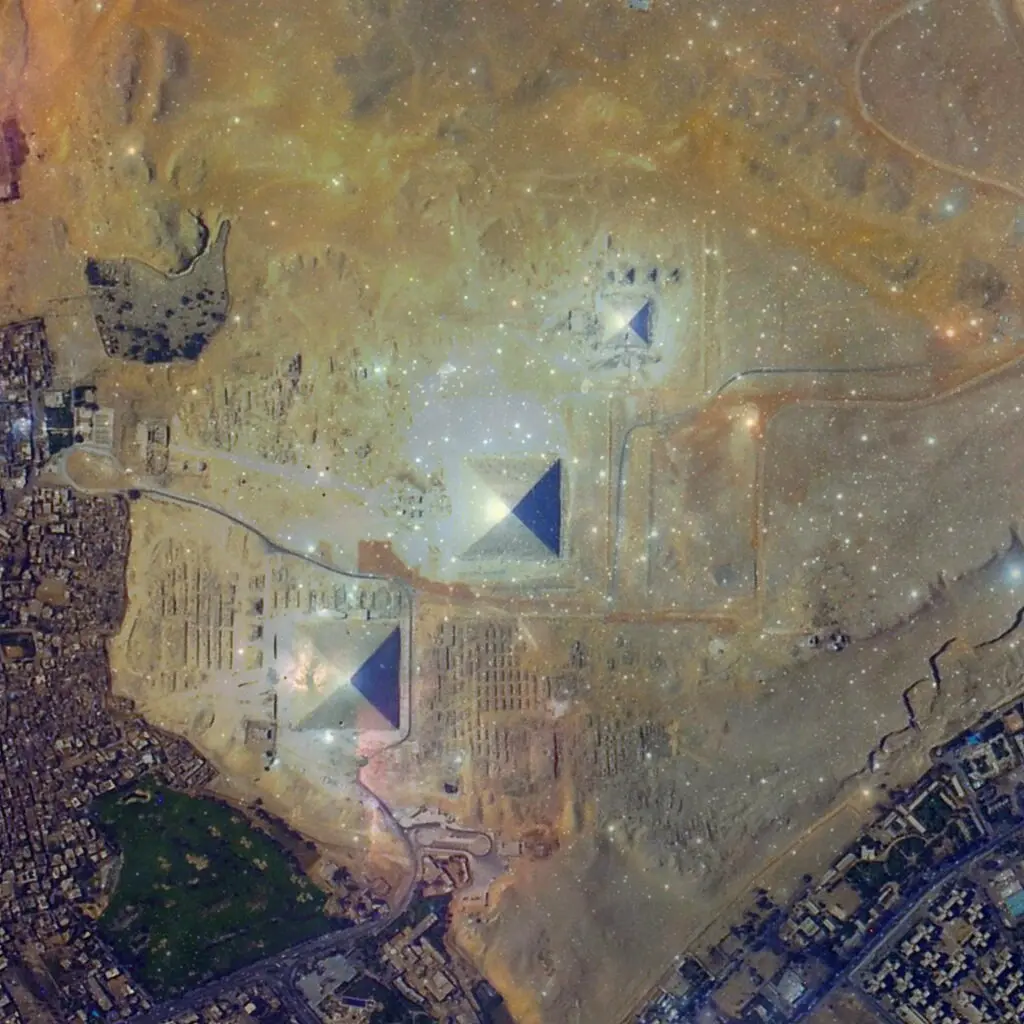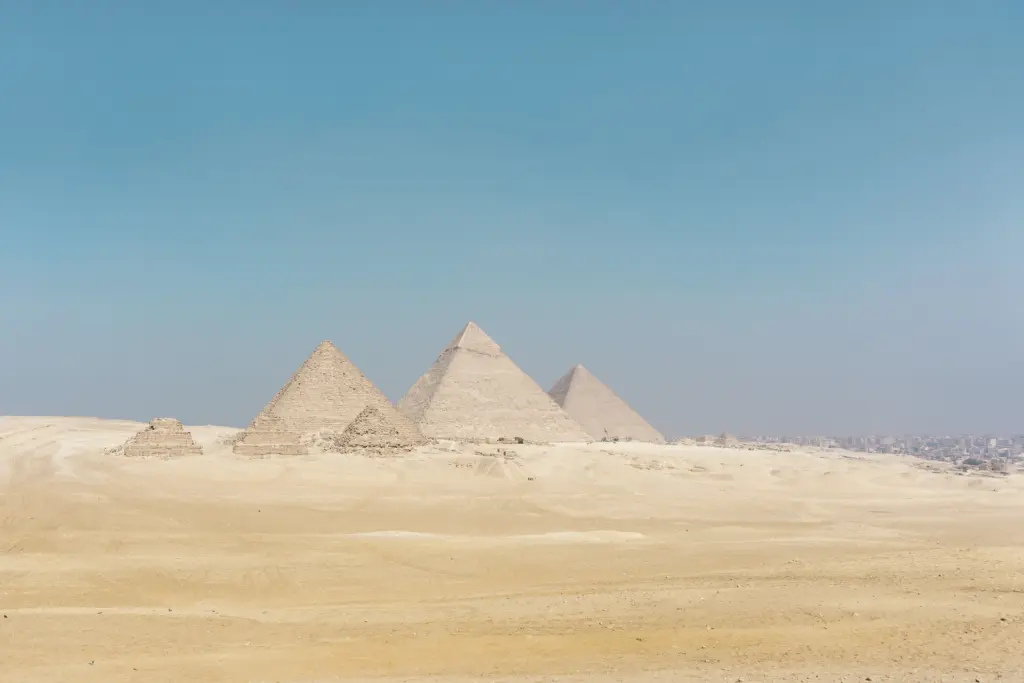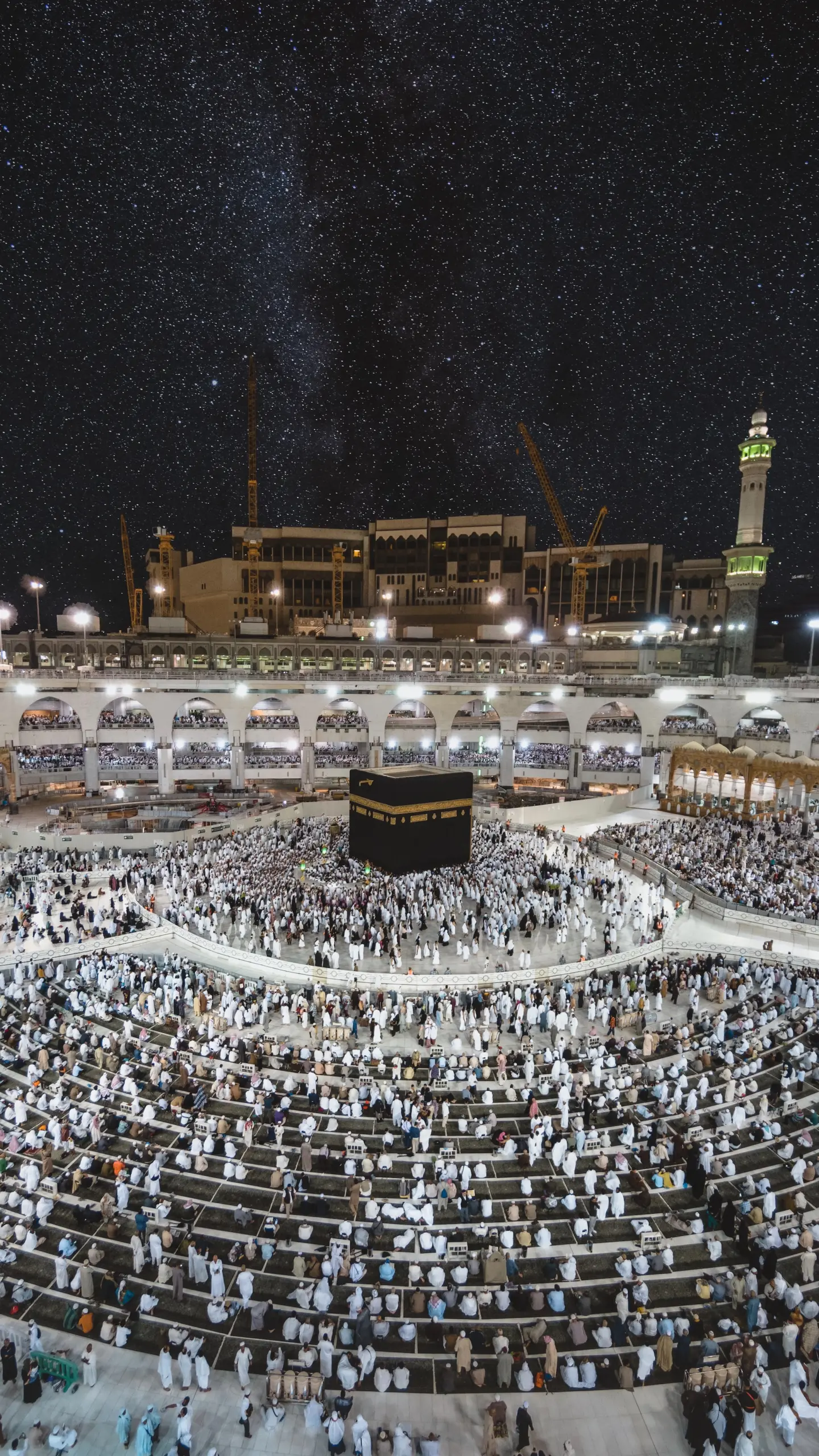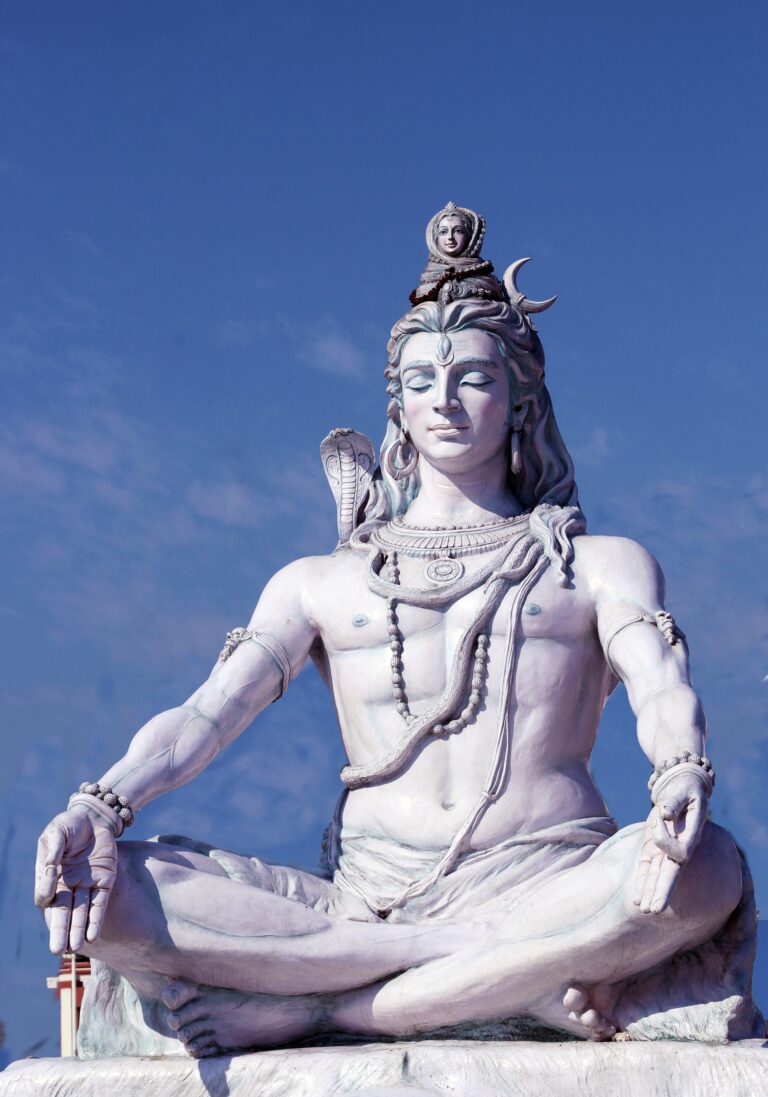The Giza pyramids, standing tall against the backdrop of Cairo and the Egyptian desert, have always been shrouded in mystery.
For centuries, they’ve been a testament to humanity’s architectural prowess and the mesmerizing allure of ancient Egypt.
But what if these iconic structures held secrets not just of our past, but of the universe itself?
It’s tempting to ponder on their purpose beyond being magnificent tombs. The alignment, the precision, the geometry—it all seems too perfect to be mere coincidence.
And here lies a captivating theory that has thrilled scholars for decades: the intricate link between the pyramids and the stars. The ancient Egyptians didn’t just build towards the heavens but rather built with them in mind.
Let’s unravel the celestial secrets of the Giza pyramids.
Table of Contents
Toggle
History of the Pyramids
The Giza pyramid complex, crowned by the Great Pyramid of Khufu, is an architectural marvel built during the Fourth Dynasty of the Old Kingdom, roughly around 2580 – 2560 BCE. Their construction being monuments for the resting place of the pharaohs.
Employing an impressive workforce, which included skilled laborers, architects, and astronomers, the construction of these pyramids was a monumental task that spanned decades.
Using ingenious techniques and tools, blocks of limestone and granite, some weighing over 80 tons, were quarried, transported, and meticulously placed.

Egypt and Astronomy
Ancient Egypt, a civilization that flourished on the banks of the Nile, has always been synonymous with grandeur, complexity, and a profound connection to the cosmos.
The vast, unobstructed Egyptian night skies, dotted with shimmering stars, planets, and meteor showers were deeply intertwined with their daily life, religion, and governance.
For the ancient Egyptians, the heavens were living tales of gods, myths, and prophecies. The movement of the stars, the predictable yet awe-inspiring solar and lunar events, and the cyclical inundation of the Nile River were all celestial phenomena that had profound earthly implications.
Priests doubled as astronomers, meticulously recording stellar movements, which played pivotal roles in setting agricultural calendars, determining religious festivals, and even predicting the future of the kingdom.
Fun Facts About the Pyramids
Aside from the astronomical mysteries of the pyramids, let’s also uncover some other incredible tidbits:
Precision of Construction: The Great Pyramid’s base is level to within just 2.1 cm (0.8 in), a level of precision that’s staggering even with today’s technology. Its north-south axis is aligned to within 0.15 degrees of true north!
Enormity of the Task: It’s estimated that around 2.3 million blocks of stone, each weighing an average of 2.5 tons, were used to build the Great Pyramid. This would mean that for the pyramid’s 20-year construction period, a block had to be moved into place roughly every 2.5 minutes!
Original Casing Stones: The pyramids were originally covered with casing stones made of polished Tura limestone to make them shine brightly in the sun. Over time, most of these stones were removed.
Mystery of Construction: Despite various theories, the exact methods used to construct these colossal structures remain a mystery. From giant ramps to intricate lever systems, the debates and explorations continue to this day.
Temperature Consistency: The temperature inside the Great Pyramid remains a constant 20°C (68°F), regardless of how hot or cold it gets outside.
The Missing Capstone: The original capstone, or “pyramidion”, of the Great Pyramid is missing. Historians aren’t sure if it was ever there, but if it existed, it might have been made of gold.
Symbol of Power: The original height of the Great Pyramid was 146.6 meters (481 feet), but it is now slightly shorter due to the loss of the outer casing stones. Still, it remained the tallest man-made structure in the world for nearly 4,000 years.
Earth’s Dimensions: The Great Pyramid’s dimensions encode geographical knowledge, with its perimeter equating to a surprisingly accurate estimation of Earth’s circumference and its height correlating with the distance from the equator to the North Pole.

Giza's Stellar Alignment
To start things off, let’s take a look at the alignment of the Pyramids with Orion’s Belt.
Gazing up at the night sky, Orion (the Hunter who was killed by Scorpio in traditional Astrology and Greek Mythology), is one of the most distinctive and easily recognizable constellations.
Its belt, comprised of three closely spaced, bright stars in a straight line, seems to have an earthly resemblance in the layout of the three Giza pyramids. The correlation between the positions of the pyramids and the stars of Orion’s Belt is uncannily accurate, with the smallest pyramid offset slightly, mirroring the third star in Orion’s Belt.
The ancient Egyptians built not just in alignment with these stars but also scaled the pyramids to reflect the varying brightness of these stars.
The Great Pyramid, representing the brightest star, Alnitak, is the largest, followed by the slightly smaller Pyramid of Khafre, corresponding to Alnilam, and then the more modest Pyramid of Menkaure, mirroring Mintaka.

Why is Orion Significant?
The importance of Orion in ancient Egyptian cosmology cannot be overstated. The constellation held deep religious and cultural significance.
To the ancient Egyptians, Orion was closely associated with Osiris, the god of rebirth and the afterlife.
Osiris was one of the most revered and influential deities in the Egyptian pantheon. The myths surrounding him touch upon themes of death, resurrection, and the cyclical nature of life, mirroring the cyclical appearance and disappearance of the Orion constellation.
Moreover, the river Nile, the lifeblood of ancient Egyptian civilization, runs parallel to the pyramids, much like the Milky Way runs parallel to Orion in the night sky. This further cemented the connection, with the Milky Way often being seen as the celestial representation of the Nile and a pathway for the souls of the deceased, guided by Osiris.

Pyramid of Khufu's Astronomical Shaft
Hidden within the colossal stone layers of the Great Pyramidof Khufu, are narrow corridors or “star shafts”. These shafts, measuring just a few inches across, ascend from the King and Queen’s chambers and penetrate deep into the pyramid, pointing directly towards the sky.
The precision with which these shafts were constructed is staggering, given the period in which they were built. Detailed astronomical analysis and modern technology have shown that these shafts align with specific star systems:
-
Queen’s Chamber Northern Shaft: This shaft, originating from the Queen’s Chamber, is aligned with the star Ursa Minor, commonly known as the Little Dipper. Ursa Minor was significant in ancient Egyptian astronomy due to its association with the circumpolar stars, which never set and were thus deemed “imperishable” or “undying.”
-
Queen’s Chamber Southern Shaft: This shaft points directly towards the constellation of Orion, particularly to the star Sirius (associated with the goddess Isis). Sirius held a special place in ancient Egyptian cosmology due to its yearly rising, which closely coincided with the start of the Nile’s annual flood, heralding the beginning of the agricultural season.
-
King’s Chamber Northern Shaft: This particular shaft aligns with the constellation Ursa Major, the Great Bear or Big Dipper. Like Ursa Minor, this constellation was part of the circumpolar group, symbolizing eternity and the immortality of the soul.
-
King’s Chamber Southern Shaft: This shaft, perhaps the most famous, points towards Orion’s Belt, further emphasizing the pyramid’s intimate connection with this constellation and the god Osiris.

What is the Purpose of the Star Shafts?
Several theories have emerged regarding the purpose of these star shafts:
Spiritual Ascension: Many scholars believe that these shafts served a religious purpose, allowing the pharaoh’s soul to ascend to the stars, ensuring his rebirth and eternal life among the gods, particularly with the “imperishable” stars.
Astronomical Observatories: Some theories suggest that these shafts acted as a sort of ancient astronomical observatory, allowing priests or the pharaoh himself to observe specific celestial events.
Architectural Ventilation: A more practical theory posits that these shafts served as a means of ventilation during the pyramid’s construction, although this is less likely given the precision of their alignment with particular star systems.
Symbolic Representation: The shafts might also serve as symbolic channels, highlighting the pharaoh’s dual nature as both a mortal ruler and a divine being. By aligning with specific stars, the pyramid underscored the pharaoh’s connection with various deities and cosmic events.

The Giza Pyramids & Celestial Events
The ancient Egyptians held solar and lunar events in great reverence, and these celestial occurrences, brimming with symbolism, left imprints on the pyramids and their associated rituals.
Solar Events
Solstices: The solstices, marking the longest and shortest days of the year, have always been powerful symbols of rebirth and transformation. The Pyramid of Khufu’s sides are closely aligned with the cardinal directions. On the summer solstice, the pyramid’s southern face is bathed in sunlight while its two adjacent faces are in shadow, creating a play of light and dark which symbolize the duality of life and death, or day and night.
Equinoxes: Equinoxes, times when day and night are equal, symbolized balance and harmony for the ancient Egyptians. During the equinoxes, the Giza pyramids cast shadows that, due to their precise orientation, have been used as markers for ceremonial events.
Lunar Events
Lunar Eclipses: The ancient Egyptians saw the moon as a symbol of rebirth and regeneration. While solar eclipses were often feared, lunar eclipses might have been perceived differently. Some researchers speculate that certain aspects of the pyramids, like the bend in the Pyramid of Bent, could potentially mark lunar cycles.
Lunar Standstills: Similar to the solstices for the sun, the moon has points in its 18.6-year cycle where its declination is at its maximum or minimum. Alignments between the pyramids and these lunar standstills have been used to predict important calendrical events.

Giza Pyramid Layout & Sacred Geometry
The Giza plateau is rife with the Egyptians’ knowledge of Sacred Geometry. These principles, often seen as the “Blueprints of the Universe”, find intriguing intersections with the pyramids.
The Giza plateau is meticulously planned. The three pyramids are aligned in a near-perfect southwest-northeast diagonal. This layout was no accident and it embodyies deeper geometrical truths:
Golden Ratio (Phi): The golden ratio, roughly 1.61803398875, is a unique number that emerges when a line is divided in such a way that the ratio of the whole line to the larger segment is the same as the ratio of the larger segment to the smaller segment. The Great Pyramid of Giza embodies this ratio. If the half-base of the pyramid is taken as 1, its slant height approximates Phi.
Pi and the Pyramids: The ratio of the pyramid’s perimeter to its height seems to approximate 2π. This suggests that the ancient Egyptians might have had an understanding of this critical mathematical constant, long before it was “officially” recognized in the world of mathematics.
The Vesica Piscis: This shape, formed by the overlap of two circles with the same radius, intersecting in such a way that the center of each circle lies on the circumference of the other, is one of the more prominent symbols of sacred geometry. The foundational footprint of the pyramids are interpreted as having connections to the Vesica Piscis, representing unity, duality, and the birth of the cosmos.

Sacred Geometry and Astronomy
Given the evident astronomical alignments in the Giza plateau, it’s plausible that sacred geometry was used to mirror celestial patterns:
Earth and Moon Proportions: Some researchers have drawn parallels between the geometry that describes the relative sizes of the Earth and Moon and the geometry of the Great Pyramid. The idea is that if you draw two circles, one outside the pyramid touching all four corners and one inside touching all four sides, the larger circle’s radius (that of the Earth) and the smaller circle’s radius (that of the Moon) have a unique relationship, akin to the Earth and Moon’s relative sizes.
Square Circles: The Giza pyramids seem to “square the circle,” a geometric problem of creating a square and a circle with the same area using only a ruler and compass. This, if intentional, could symbolize the harmonization of heaven (represented by the circle) and earth (represented by the square).
Plan Your Trip to Egypt | Best Travel Resources
Book Your Accommodations
- Booking.com – the world’s leading online booking platform for accomodations around the world, they have an extensive amount of available listings with zero booking fees and best price guarantees.
- Hostelworld – a backpacker’s best friend, Hostelworld has the largest collection of hostels and guesthouses for affordable prices.
Don’t Forget Insurance
- SafetyWing – from Nomad Insurance, an insurance by nomads for nomads. They understand our lifestyle well and have really comprehensive and flexible plans that cater to any traveler.
Find Cheap Flights
- Kiwi.com – my go-to for booking and finding the cheapest flights and it’s helped me save tons of money. They do virtual interlining which is connecting flights from airlines that do not codeshare, so you can find routes that you wouldn’t be able to find normally.
Join Tours & Activities
- GetYourGuide – is one of the best places to find unique tours and activities. I found that it’s an excellent way to meet fellow travelers and create fond memories. They are not only limited to tours as they also offer niche services such as skip-the-line tickets or private transfers.
Catch a Ride
- Rentalcars.com – nothing beats the freedom of the road, Rentalcars.com is the world’s largest online car rental service. They operate across 160 countries so they’re the perfect partner to work with if you find yourself wanting a ride.













